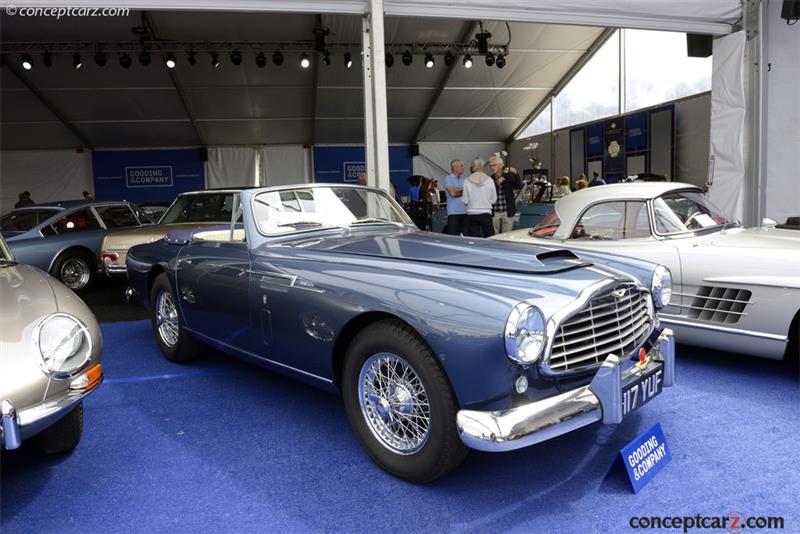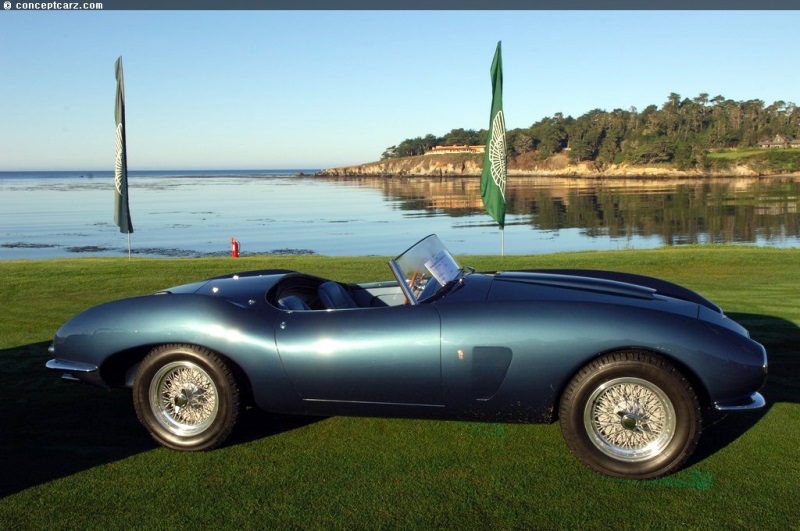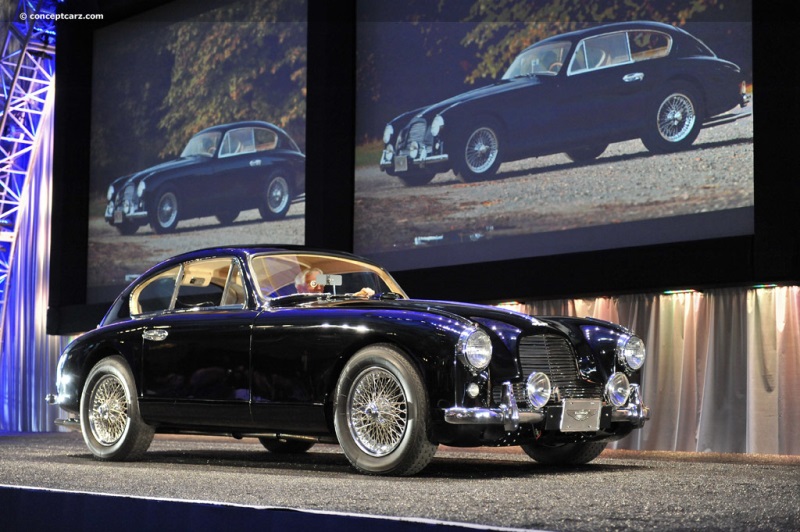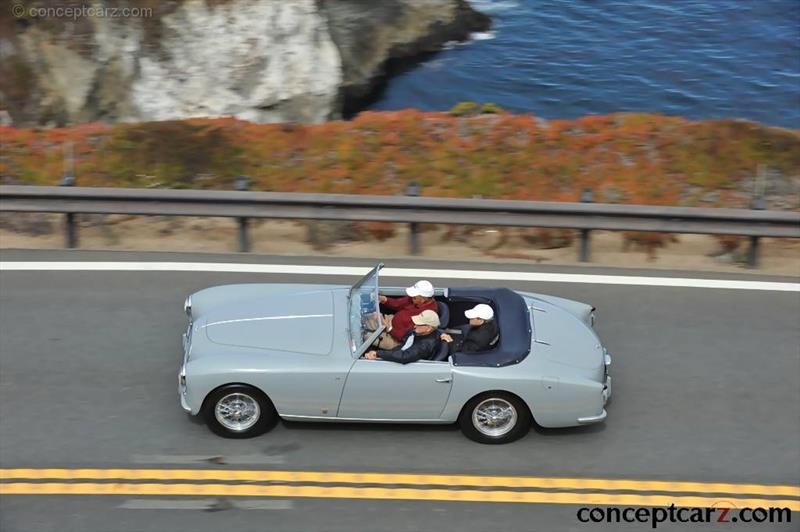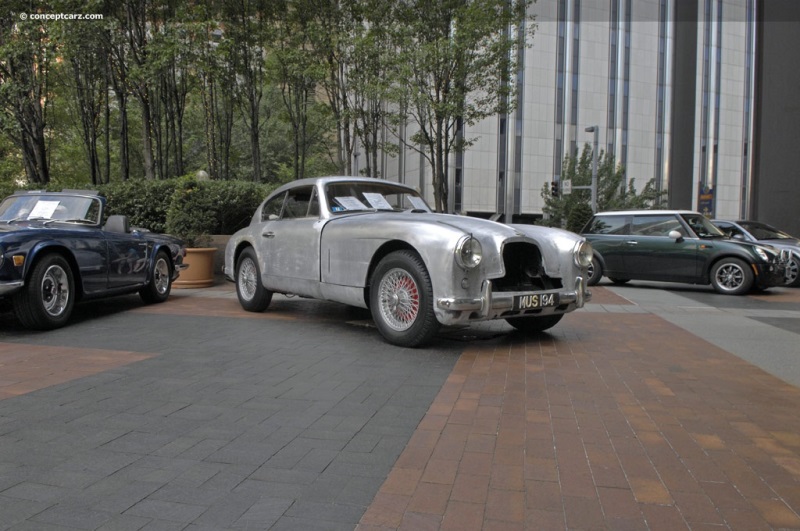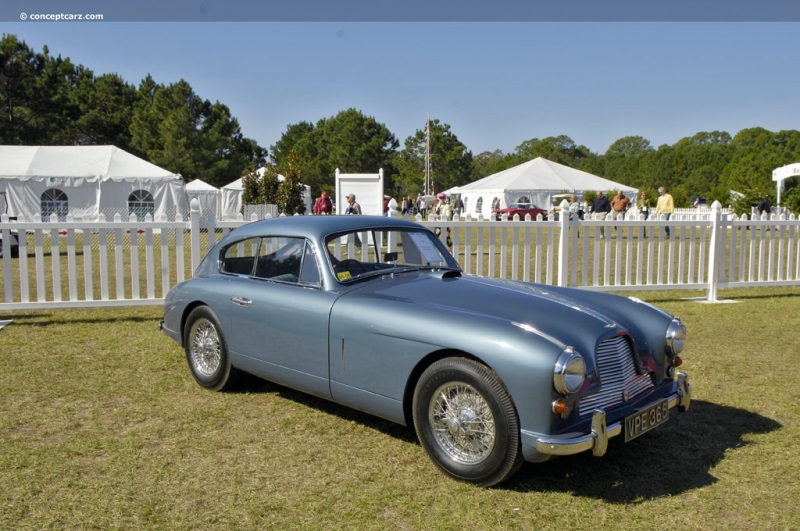Lionel Martin and Robert Bamford formed Bamford & Martin in 1912 for the purpose of selling cars may be Singer from premises in Callow Street London. A short time later, they decided to make their own vehicles, and Aston Martin was founded in 1913. Their vehicle was built in new facilities at Henniker Mews in Kensington in March of 1915. 
Coupe by Bertone
Chassis #: LML/765
Engine #: VB6J/213
View info and history
Auction entries : 2Over the years that followed, the Bamford & Martin built vehicles established world speed and endurance records, and won numerous races. They were highly competitive and exclusive vehicles, that were built in limited numbers. Despite the popularity, the company was rescued from financial difficulty in 1925, and by this point in history, Bamford had already left, and Martin was forced to sell the company. Later renamed Aston Martin Motors, the company enjoyed a few prosperous years until the Great Depression re-introduced financial problems in 1932. It was rescued for a year by Lance Prideaux Brune before passing it on to Sir Arthur Sutherland. Automobile production continued until the outbreak of World War II before they turned their talents to building aircraft components in support of the war effort.Aston Martin DB2 and the 2.6-liter Lagonda Engine
Following World War II, the floundering Aston Martin company was acquired by wealthy Yorkshire industrialist David Brown, who acquired another British marque named Lagonda as well and incorporated them as Aston Martin Lagonda Ltd. The Lagonda company was prized for its 2,580cc (2.6-liter) dual overhead camshaft, a straight-six engine that was much more powerful than the pushrod 2.0-liter straight-4 unit powering the Aston Martin 2-Litre Sports. The Lagonda engine had been built by William (Willie) Watson under W.O. Bentley's supervision. It had a 78mm bore and a stroke of 90 mm, and developed 105 horsepower with dual SU carburetors. The first product of the marriage between Lagonda and Aston Martin was the 2-litre Sports of which only 13 examples plus a chassis were produced. Retrospectively dubbed the DB1, the model laid the foundation of an aspirational line of cars that continues to this day. The Lagonda engine was placed in the engine bay of a shortened tube-frame chassis designed by Claude Hill. The wheelbase measured 99-inches, the width 65-inches, the height 53.5-inches, and the length of 162.5-inches. The fastback coupe body design was courtesy of Frank Feeley.
Spyder by Bertone
Chassis #: LML/505
Engine #: VB6J/91
View info and history
Auction entries : 11949 24 Hours of LeMans
Prior to DB2 production commencing, three early examples were entered in the 24 Hours of Le Mans in 1949. One example was equipped with the Lagonda straight-6 engine while the other two utilized the four-cylinder Aston Martin 2-liter unit. One of the 2-liter cars was in fourth place but crashed two hours short of the finish due to lack of brakes, fatally injuring driver Pierre Maréchal. Arthur Jones and Nick Haines drove the other 2-liter car to 7th place. Leslie Johnson drove the Lagonda-powered car for six laps before it was forced to retire due to overheating caused by the failure of the water pump. 1949 Spa 24 Hour
Leslie Johnson and Charles Brackenbury drove the six-cylinder Lagonda-powered Aston Martin DB2 to a 3rd place finish in the 1949 Spa 24 Hour race, just a month after its premature retirement at Le Mans, proving it was capable of enduring the 24-hour race. One of the 2-liter cars, driven by Nick Haines and Lance Macklin, placed 5th. 1950 and 1951 Season
With the Lagonda engine proven in the rigors of competition, Aston Martin outfitted all three factory team cars with the engine for the 1950 season. George Abecassis and Lance Macklin placed 5th at the Le Mans race, and Reg Parnell placed 6th, earning Aston Martin 1st and 2nd in the 3-liter class. In December of 1950, Briggs Cunningham drove a DB2 to 2nd in class at the inaugural Sebring race meeting.
Fastback Coupe by Mulliner
Chassis #: LML/747
Engine #: VB6J/185
View info and history
Auction entries : 1The team returned to Le Mans in 1951 where Macklin and Eric Thompson took 3rd overall, with Abecassis and Brian Shawe-Taylor 5th.Aston Martin DB2 Production
The production version of the Aston Martin DB2 was introduced in April of 1950 at the New York Auto Show and would remain in production through April of 1953, with 411 examples built during that time. Most body styles were the Fixed Head Coupe (FHC); a Drophead Coupe (DHC) variant was introduced later in 1950 with approximately 102 examples built. Modifications and changes were continuous on these hand-built vehicles, and the first 49 examples received large rectangular cooling vents in the front wings, and a chrome-framed front grille in three separate parts. The remaining examples did not have side vents and wore a one-piece grille with horizontal chrome slats. Shortly after production began, the engine was offered with larger carburetors and higher compression ratio pistons. This became known as the Vantage, boosting output from around 105 bhp to 125 bhp. Aston Martin DB2/4
Although the DB2 had been a success, Aston Martin wanted to widen its appeal, resulting in the introduction of the 2+2 DB2/4 in October of 1953. The fuel tank capacity was reduced from nineteen to seventeen gallons, and the rear of the chassis was modified, liberating sufficient space within the existing design for two child-size occasional rear seats. Alternatively, the rear seat backs could be folded down, more than doubling the luggage space capacity, which could be accessed via a hatchback rear door. Styling updates included a raised roofline, a one-piece windscreen, repositioned headlights, and larger bumpers.
Fastback Coupe by Touring
Chassis #: LML 664
Engine #: VB6E/50/1371
View info and historyThe Aston's opening tailgate made the DB2/4 the world's first 'hatchback'. As with the DB2, the whole front body section hinged forward to provide access to the engine and front suspension.Much of the mechanical aspects of the DB2 remained consistent with the DB2/4, employing the latter's rectangular-tube chassis, trailing arm independent front suspension and well-located live rear axle with parallel radius arms and coil springs. The W.O. Bentley-designed 2.6-liter, twin-cam, six-cylinder engine continued to offer 125 horsepower in Vantage specification as standard for the 2/4. Braking was by 12-inch Girling drum units all round.The wheelbase remained the same but the length increased by seven inches, resulting in inevitable weight gain not fully compensated for until the arrival of the 3.0-liter, DB3S-derived, 140bhp engine in 1954. Zero-to-sixty mph was accomplished in around 11 seconds and the top speed was 118 mph.
Drophead Coupe
Chassis #: LML 562
Engine #: VB6E/50/1294
View info and history
Auction entries : 3DB2/4 Competition
The Aston Martin DB2/4 was designed for Grand Touring and not for racing, yet despite this, it did have an impressive competition career which began early in1 955 when the Aston Martin Works entered three cars in the Monte Carlo Rally. Reg Parnell was joined by motor racing photographer Louis Klemantaski in one car, Peter Collins and Graham Whitehead shared the second, while the third was crewed by two former Monte winners, Dutchman Maurice Gatsonides and Frenchman Marcel Becquart. The cars driven by Parnell and Collins went 'flat-out' from the start, resulting in penalties when they arrived at the checkpoints too early, effectively putting them out of the competition. Parnell was then disqualified before the car got back to Monte Carlo. Collins was able to continue and won the traditional race around the Monaco GP Circuit. Gatsonides and Becquart led the rally until they passed a secret time-check, and dropped to seventieth place. They were awarded the RAC Trophy for 'Comfort and Safety' for their performance.DB2/4 Mark II
Subtle styling changes to the DB2/4 brought about the Mark II (MK II) in 1955. The most significant change was a 3/4-inch increase in roof height that afforded greater headroom. The bonnet horizontal split line changed fro door sill height to a line traversing rearwards from the top of the front wheel arch. There were small tailfins, additional chrome, and bubble-type tail lights. The Mark II continued to be available as a close-coupled sports saloon or drophead coupé, while for the first time the factory offered an alternative fixed-head coupé, of which only 34 were made.The Aston six had been enlarged from 2.6 to 3.0 liters partway through the production of the DB2/4 MkI and continued unchanged in the MkII, though a special series VB6J engine suffixed 'L' or 'L1' producing 165bhp was available as an option.
Fastback Coupe by Mulliner
Chassis #: LML 551
Engine #: VB6J/120
View info and history
Auction entries : 2David Brown had acquired Tickford in 1954 and would move all of Aston Martin's operations there with the start of DB4 production. During Mark II production, coachbuilding responsibilities shifted from Mulliner's of Feltham to Tickford's works in Newport Pagnell. DB2/4 Production
Production of the DB2/4 began in 1953 and continued through 1957, with a total of 764 examples built during that time. 565 of those were Mark I and 199 were Mark II versions. Of the Mark I models, 102 examples were Drophead Coupes and around 4 or 5 were Spiders bodied by Bertone. Of the 199 examples of the Mark II, 34 were Fixed Head Coupes, 16 as Drophead Coupes, and 3 were Spiders bodied by Touring. A number of special bodied cars were also produced by Italian coachbuilders Carrozzeria Allemano, Bertone, and Vignale who were commissioned at special request by private clients. DB2/4 Mark II Successor
The Mark II was replaced in 1957 by the DB 2/4 Mark III (more commonly known as the DB Mark III) and produced through 1959 with 551 examples built. The DBIII was an evolution of its predecessors, incorporating several styling and mechanical changes. Among the most significant updates were Girling disc brakes, a new instrument panel, and twin SU carburetors. The 2.9-liter Lagonda inline-6 delivered 162 horsepower or 178 hp with the optional dual-exhaust system installed. Zero-to-sixty mph was now accomplished in 9.3 seconds and the top speed was 120 mph. For enthusiasts seeking even more power, Aston Martin offered an optional high-output DBB engine with three twin-choke Weber 35 DCO 3 carburetors, higher compression pistons (8.6:1), dual exhaust system, and special long-duration camshafts which brought horsepower to nearly 200 bhp.
Drophead Coupe by Bertone
Chassis #: LML/506
Engine #: VB6E/50/337
View info and history
Auction entries : 4The DB Mark III was replaced by the DB4 which was produced from 1957 to 1963 with 1,204 examples built.
by Daniel Vaughan | Nov 2021
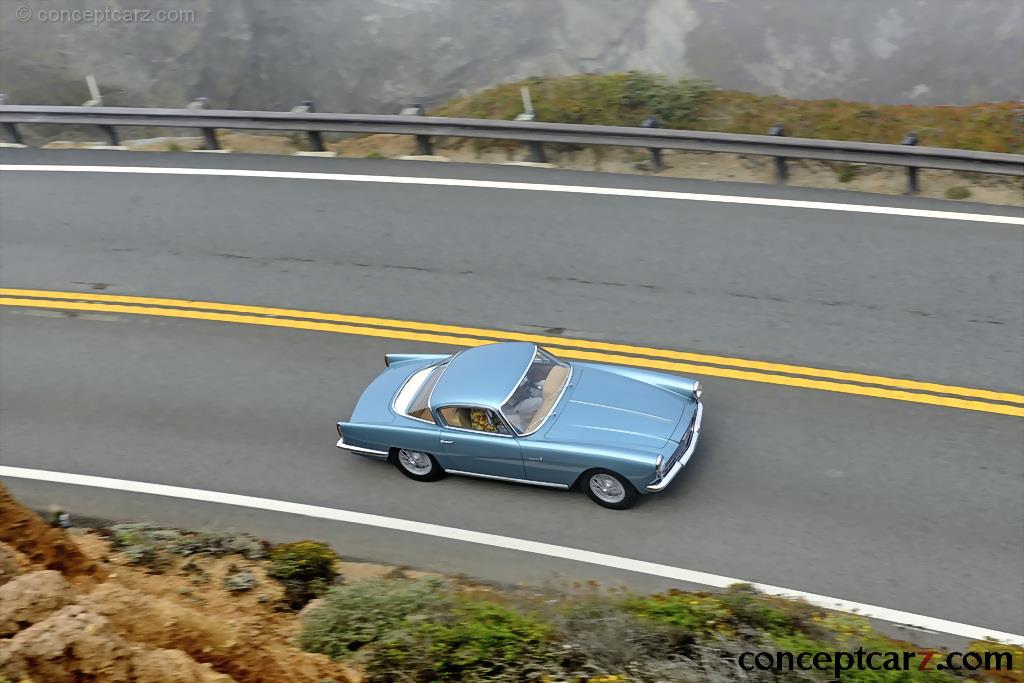
Coupe by Bertone
Chassis #: LML/765
Engine #: VB6J/213
View info and history
Auction entries : 2
Following World War II, the floundering Aston Martin company was acquired by wealthy Yorkshire industrialist David Brown, who acquired another British marque named Lagonda as well and incorporated them as Aston Martin Lagonda Ltd. The Lagonda company was prized for its 2,580cc (2.6-liter) dual overhead camshaft, a straight-six engine that was much more powerful than the pushrod 2.0-liter straight-4 unit powering the Aston Martin 2-Litre Sports. The Lagonda engine had been built by William (Willie) Watson under W.O. Bentley's supervision. It had a 78mm bore and a stroke of 90 mm, and developed 105 horsepower with dual SU carburetors. The first product of the marriage between Lagonda and Aston Martin was the 2-litre Sports of which only 13 examples plus a chassis were produced. Retrospectively dubbed the DB1, the model laid the foundation of an aspirational line of cars that continues to this day. The Lagonda engine was placed in the engine bay of a shortened tube-frame chassis designed by Claude Hill. The wheelbase measured 99-inches, the width 65-inches, the height 53.5-inches, and the length of 162.5-inches. The fastback coupe body design was courtesy of Frank Feeley.
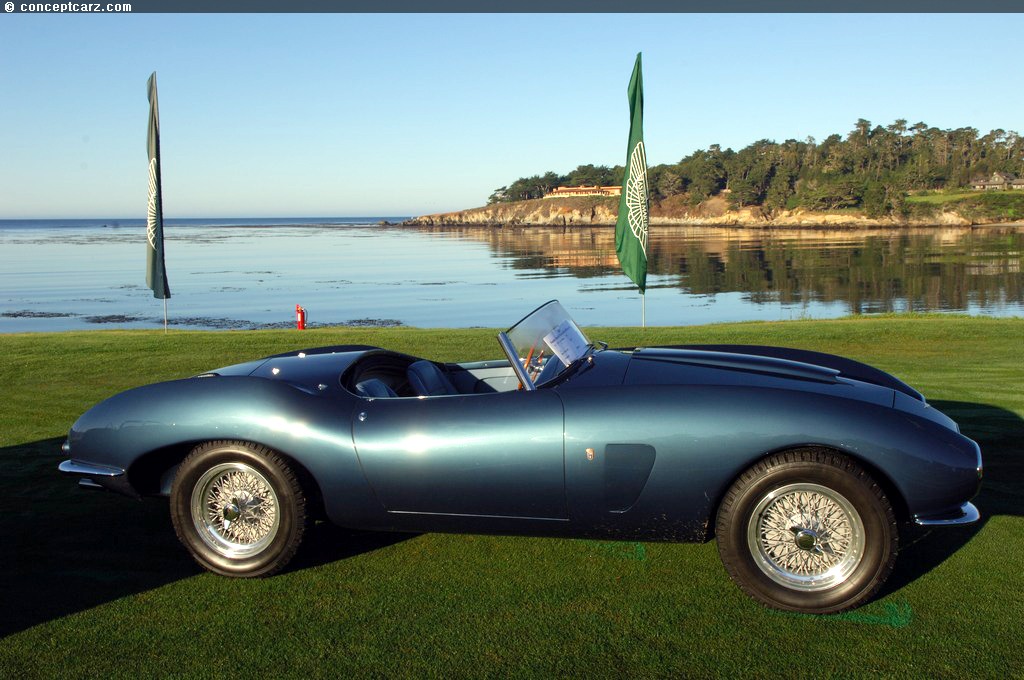
Spyder by Bertone
Chassis #: LML/505
Engine #: VB6J/91
View info and history
Auction entries : 1
Prior to DB2 production commencing, three early examples were entered in the 24 Hours of Le Mans in 1949. One example was equipped with the Lagonda straight-6 engine while the other two utilized the four-cylinder Aston Martin 2-liter unit. One of the 2-liter cars was in fourth place but crashed two hours short of the finish due to lack of brakes, fatally injuring driver Pierre Maréchal. Arthur Jones and Nick Haines drove the other 2-liter car to 7th place. Leslie Johnson drove the Lagonda-powered car for six laps before it was forced to retire due to overheating caused by the failure of the water pump. 1949 Spa 24 Hour
Leslie Johnson and Charles Brackenbury drove the six-cylinder Lagonda-powered Aston Martin DB2 to a 3rd place finish in the 1949 Spa 24 Hour race, just a month after its premature retirement at Le Mans, proving it was capable of enduring the 24-hour race. One of the 2-liter cars, driven by Nick Haines and Lance Macklin, placed 5th. 1950 and 1951 Season
With the Lagonda engine proven in the rigors of competition, Aston Martin outfitted all three factory team cars with the engine for the 1950 season. George Abecassis and Lance Macklin placed 5th at the Le Mans race, and Reg Parnell placed 6th, earning Aston Martin 1st and 2nd in the 3-liter class. In December of 1950, Briggs Cunningham drove a DB2 to 2nd in class at the inaugural Sebring race meeting.
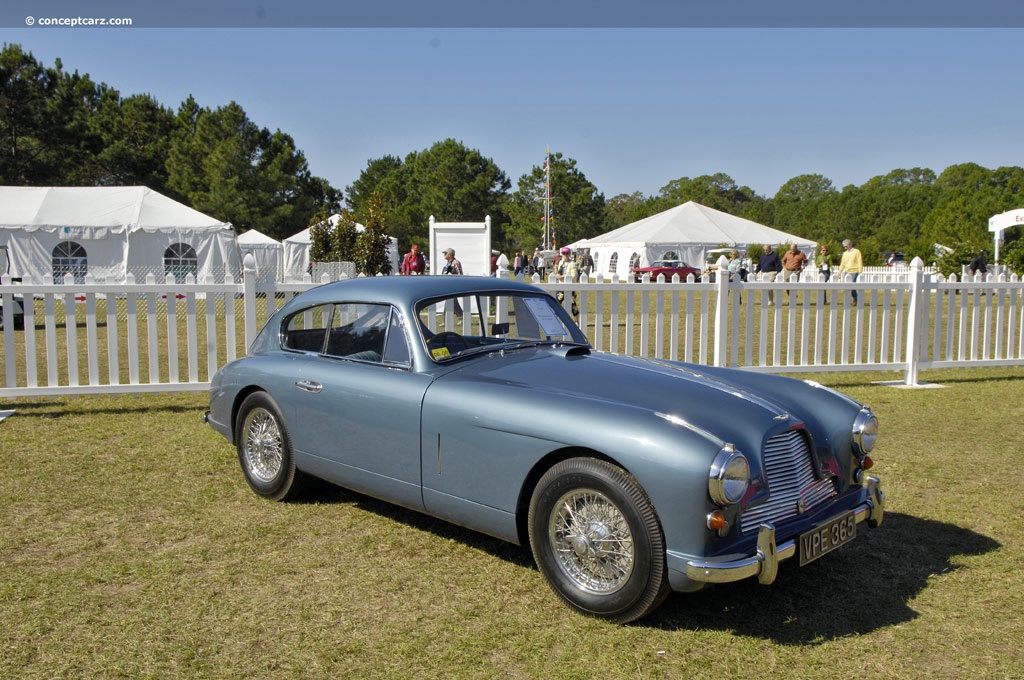
Fastback Coupe by Mulliner
Chassis #: LML/747
Engine #: VB6J/185
View info and history
Auction entries : 1
The production version of the Aston Martin DB2 was introduced in April of 1950 at the New York Auto Show and would remain in production through April of 1953, with 411 examples built during that time. Most body styles were the Fixed Head Coupe (FHC); a Drophead Coupe (DHC) variant was introduced later in 1950 with approximately 102 examples built. Modifications and changes were continuous on these hand-built vehicles, and the first 49 examples received large rectangular cooling vents in the front wings, and a chrome-framed front grille in three separate parts. The remaining examples did not have side vents and wore a one-piece grille with horizontal chrome slats. Shortly after production began, the engine was offered with larger carburetors and higher compression ratio pistons. This became known as the Vantage, boosting output from around 105 bhp to 125 bhp. Aston Martin DB2/4
Although the DB2 had been a success, Aston Martin wanted to widen its appeal, resulting in the introduction of the 2+2 DB2/4 in October of 1953. The fuel tank capacity was reduced from nineteen to seventeen gallons, and the rear of the chassis was modified, liberating sufficient space within the existing design for two child-size occasional rear seats. Alternatively, the rear seat backs could be folded down, more than doubling the luggage space capacity, which could be accessed via a hatchback rear door. Styling updates included a raised roofline, a one-piece windscreen, repositioned headlights, and larger bumpers.
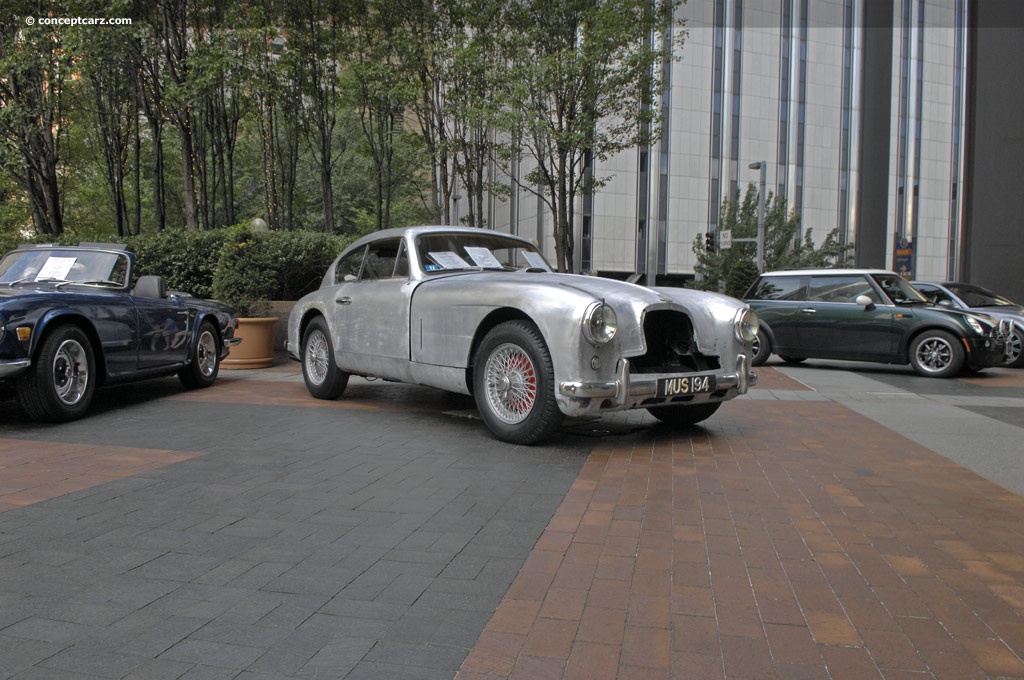
Fastback Coupe by Touring
Chassis #: LML 664
Engine #: VB6E/50/1371
View info and history
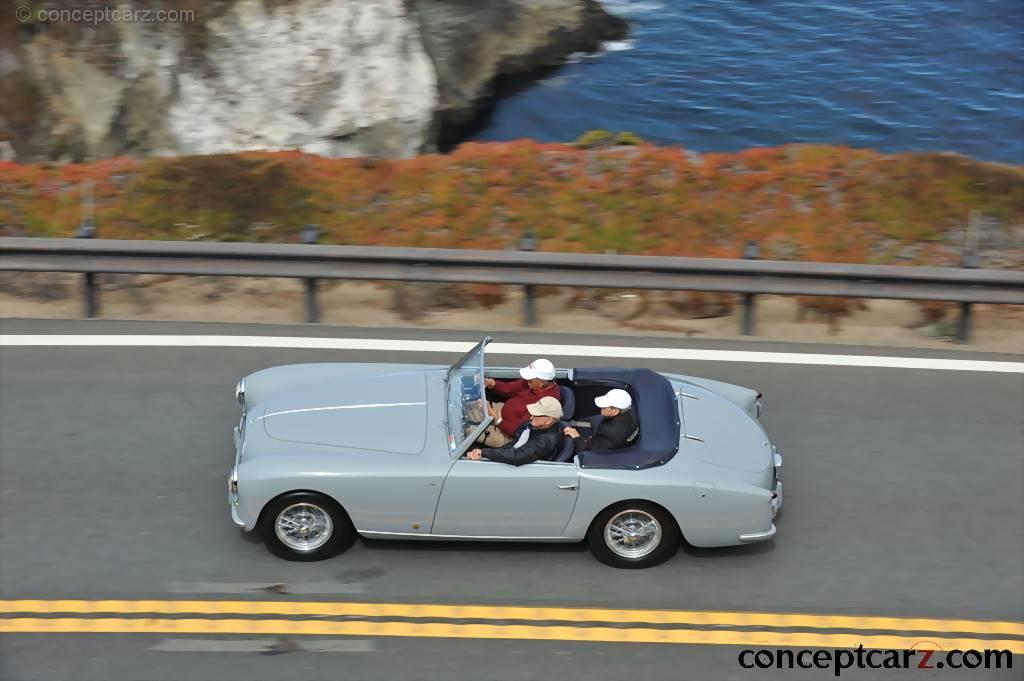
Drophead Coupe
Chassis #: LML 562
Engine #: VB6E/50/1294
View info and history
Auction entries : 3
The Aston Martin DB2/4 was designed for Grand Touring and not for racing, yet despite this, it did have an impressive competition career which began early in1 955 when the Aston Martin Works entered three cars in the Monte Carlo Rally. Reg Parnell was joined by motor racing photographer Louis Klemantaski in one car, Peter Collins and Graham Whitehead shared the second, while the third was crewed by two former Monte winners, Dutchman Maurice Gatsonides and Frenchman Marcel Becquart. The cars driven by Parnell and Collins went 'flat-out' from the start, resulting in penalties when they arrived at the checkpoints too early, effectively putting them out of the competition. Parnell was then disqualified before the car got back to Monte Carlo. Collins was able to continue and won the traditional race around the Monaco GP Circuit. Gatsonides and Becquart led the rally until they passed a secret time-check, and dropped to seventieth place. They were awarded the RAC Trophy for 'Comfort and Safety' for their performance.DB2/4 Mark II
Subtle styling changes to the DB2/4 brought about the Mark II (MK II) in 1955. The most significant change was a 3/4-inch increase in roof height that afforded greater headroom. The bonnet horizontal split line changed fro door sill height to a line traversing rearwards from the top of the front wheel arch. There were small tailfins, additional chrome, and bubble-type tail lights. The Mark II continued to be available as a close-coupled sports saloon or drophead coupé, while for the first time the factory offered an alternative fixed-head coupé, of which only 34 were made.The Aston six had been enlarged from 2.6 to 3.0 liters partway through the production of the DB2/4 MkI and continued unchanged in the MkII, though a special series VB6J engine suffixed 'L' or 'L1' producing 165bhp was available as an option.
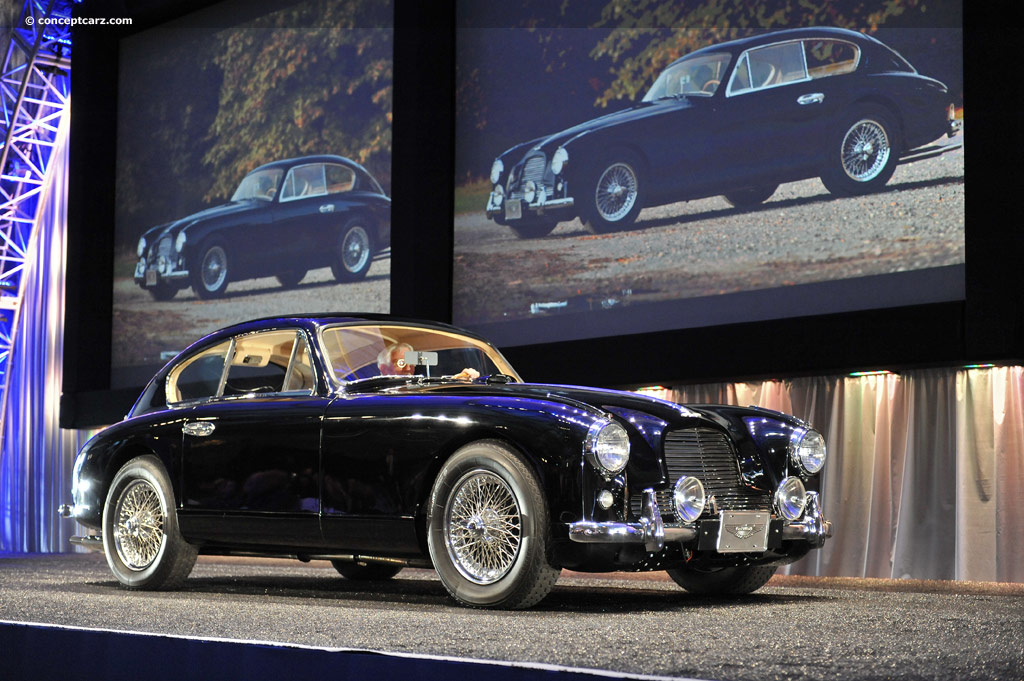
Fastback Coupe by Mulliner
Chassis #: LML 551
Engine #: VB6J/120
View info and history
Auction entries : 2
Production of the DB2/4 began in 1953 and continued through 1957, with a total of 764 examples built during that time. 565 of those were Mark I and 199 were Mark II versions. Of the Mark I models, 102 examples were Drophead Coupes and around 4 or 5 were Spiders bodied by Bertone. Of the 199 examples of the Mark II, 34 were Fixed Head Coupes, 16 as Drophead Coupes, and 3 were Spiders bodied by Touring. A number of special bodied cars were also produced by Italian coachbuilders Carrozzeria Allemano, Bertone, and Vignale who were commissioned at special request by private clients. DB2/4 Mark II Successor
The Mark II was replaced in 1957 by the DB 2/4 Mark III (more commonly known as the DB Mark III) and produced through 1959 with 551 examples built. The DBIII was an evolution of its predecessors, incorporating several styling and mechanical changes. Among the most significant updates were Girling disc brakes, a new instrument panel, and twin SU carburetors. The 2.9-liter Lagonda inline-6 delivered 162 horsepower or 178 hp with the optional dual-exhaust system installed. Zero-to-sixty mph was now accomplished in 9.3 seconds and the top speed was 120 mph. For enthusiasts seeking even more power, Aston Martin offered an optional high-output DBB engine with three twin-choke Weber 35 DCO 3 carburetors, higher compression pistons (8.6:1), dual exhaust system, and special long-duration camshafts which brought horsepower to nearly 200 bhp.
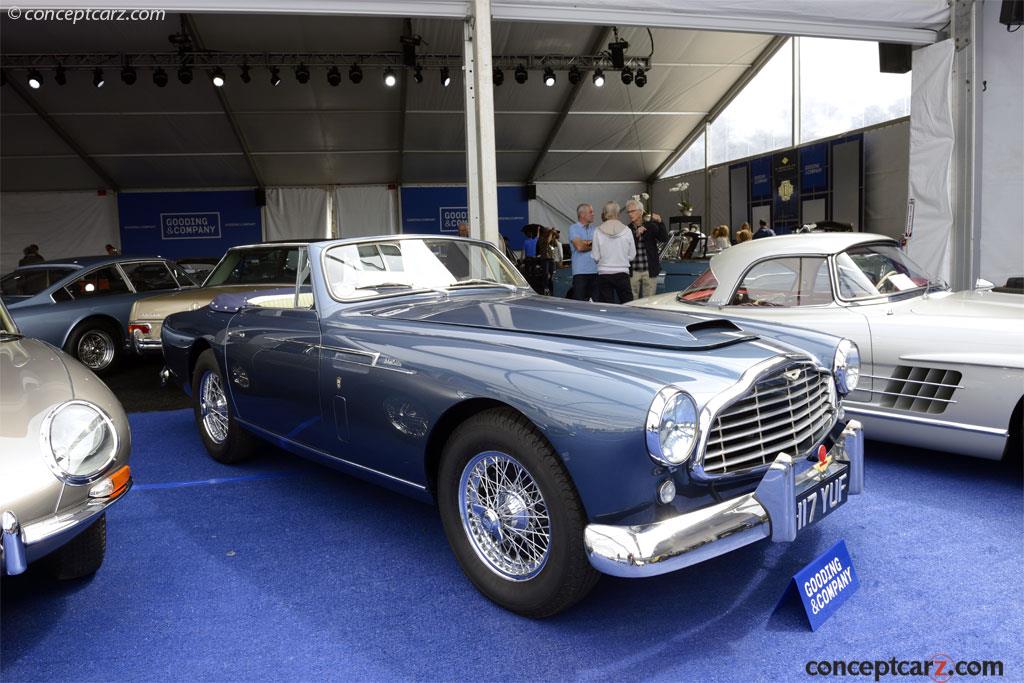
Drophead Coupe by Bertone
Chassis #: LML/506
Engine #: VB6E/50/337
View info and history
Auction entries : 4
by Daniel Vaughan | Nov 2021
Related Reading : Aston Martin DB2 History
The Aston Martin DB2 was introduced to the public at the New York Motor Show. This was not the vehicles first appearance as it had been raced at the grueling 24 Hours of LeMans where one of the drivers, Pierre Marechal, had been involved in a fatal accident. The DB2 was designed by Frank Freeley and configured as a two-seater touring vehicle. It was Aston Martins first real production vehicle. The....
Continue Reading >>
Continue Reading >>
Related Reading : Aston Martin DB2 History
The first Aston Martin was built in 1913 by London Singer dealers Robert Bamford and Lionel Martin. It was comprised of a Coventry Simplex engine and an Isotta Fraschini chassis. They were later joined by Count Louis Zborowski, who provided finical backing and was an avid racer. Under the patronage of Augustus Bertelli, the legacy of Aston Martin continued to grow in motorsports throughout the years.....
Continue Reading >>
Continue Reading >>
Aston Martin
Similar Automakers
1954 Aston Martin DB2/4 Vehicle Profiles
Drophead Coupe
Coachwork: Bertone
Designer: Giovanni Michelotti
Chassis #: LML/506
Engine #: VB6E/50/337
Recent Vehicle Additions
Performance and Specification Comparison
Price Comparison
DB2/4 Specification Comparison by Year
Year
Production
Wheelbase
Engine
Prices
Related Automotive News

1932 Duesenberg J Figoni Sports Torpedo Named Best of Show at the 71st Pebble Beach Concours d'Elegance
2022 Charitable Donations Surpass %242.67 Million
A unique Duesenberg reprised its early role as Concours winner by taking the top prize at the Pebble Beach Concours dElegance.
This year, 40 classic cars from 18 countries and 33 states pulled...

Gooding & Company Proudly Announces a Geared Online Auction – The European Sporting & Historic Collection From 28 January to 5 February 2021
Hailing from a private UK-based collection, these nine cars represent the very best of motorings most prosperous era, with highlights from Ferrari, Mercedes-Benz, Aston Martin, Bentley, and Rolls-Royce.
Gooding %26 Company, the internationally...

1929 Mercedes-Benz S Barker Tourer Named Best Of Show At The 67Th Pebble Beach Concours d'Elegance
PEBBLE BEACH, Calif. (August 20, 2017) — Just a week ago, Bruce R. McCaws 1929 Mercedes-Benz S Barker Tourer emerged from the restoration shop of Steve Babinsky in Lebanon, New Jersey. Today, having crossed the country, the boattailed beauty captured...

Exquisite Coachbuilt Offerings to be Sold at The Pebble Beach Auctions Presented by Gooding & Company
Early highlights Include the 1954 Aston Martin DB24 Spider, the 1946 Cisitalia 202 CMM, the 1960 Abarth 1000 Bialbero Record Car La Principessa, and More
Auctions will be held at the Pebble Beach Equestrian Center this August
SANTA...

63rd Pebble Beach Concours d'Elegance Names 1934 Packard 'Best of Show'
The competition showcased 248 cars, including 48 from abroad
PEBBLE BEACH, Calif. (August 18, 2013) -- A 1934 Packard 1108 Twelve Dietrich Convertible Victoria owned by Joseph and Margie Cassini III of West Orange, New Jersey, was named Best...

























